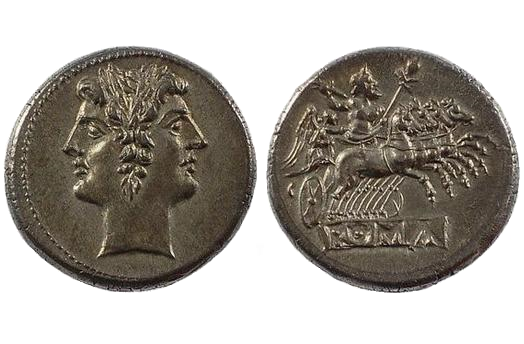
about ancient nomos
Ancient Nomos Art is a museum of galleries exhibiting ancient coins and ancient mint maps. The coin gallery displays the diverse art and history of hand-crafted ancient Greek, Roman, Byzantine, Persian and Medieval coinage. The ancient mints mapping gallery features Greek, Roman, Byzantine, Asia Minor and Medieval mint city regions and territories. Visitor's are welcome to explore, study and enjoy Ancient Nomos Art.

Roman Republic – 214 BC
Janus Didrachm
From Ancient Galleries

Obverse: Laureate head of Janus with slightly curved truncation; beaded border.
Reverse: Jupiter hurling thunderbolt and holding scepter in galloping quadriga driven by Victory to right; ROMA legend incuse on partially raised solid tablet.
LEGEND
Obv: Laureate head of Janus with annulets in hair, slightly curved truncation. Rev: Victory drives a fast moving quadriga to right. Jupiter is above and behind Victory holding long scepter in left hand and hurls a thunderbolt with right hand; below ROMA in incuse on raised solid tablet.
This coins obverse image taken together with the reverse is particularly interesting as it perhaps foretells of the Roman peoples future greatness and ambition. The obverse depicts the laureate head of Janus, known to be one of Rome’s oldest gods. In early Roman society, legends ascribed Janus as the two-faced god whose double portrait may have several meanings. Some say the two faces possess the power to see all that is going and all that is coming. While others believe Janus has the power of past knowledge and of future knowledge. Still others claim Janus placed above entry way bless those who pass below his image. Romans are known to have placed the image of Janus at the threshold of important transitions, such as entrances and passage ways, or above doors and gates considered to be holy and venerated. Sometimes the holy doors and covered passages were actually called Janus, or “Januae,” as an allusion or reference to the god’s divine powers beholden to those entering or leaving. Several Roman arches spanning Rome’s streets, chariot ways and passageways, were known to have marble Janus plaques signifying his ability to see all that is coming and going, especially the arches situated along major Roman intersections. The reverse engraving depicts a Roman quadriga of four horses charging right. Standing in the chariot is Victory with reins and spear in hand along with the flying personification of Jupiter holding a scepter and thunderbolt above. ROMA is inscribed on an incused plaque in exergue below the chariot beginning in 225 BC. The engraved word ROMA marks the first time in history the cities name appears on a Roman coin. Taken together, the obverse and reverse images symbolize Rome’s military strength, successful Punic wars, and ambition to conquer with Janus’s divine power of past and future knowledge.
SPECIAL FEATURE EXHIBIT
The ANAM Special Features gallery takes a closer look at the uniquely small, exquisitely engraved and highly artful Republican Roman Horsemen and Chariot types, circa 1st, 2nd and 3rd centuries BC. To view the Special Features coin exhibit depicting this very important form of ancient equine transportation, please use the following link: Republican Roman Horsemen and Chariot Exhibit
DOCUMENTATION
Value: Quadrigatus (Didrachm) Metal: Silver. Weight: 6.50 gms. Mint: Rome. Date: 225-212 BC.
Attribution: Crawford, Michael, 28/3; Seaby, RSC 23; Syndenham 64; BMCRR Romano-Campanian 78-99; Kestner 90-95; Hersh, Quadrigatus Coinage.
Legend, Documentation and Attribution
